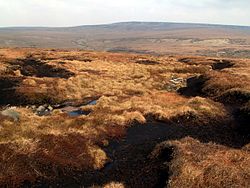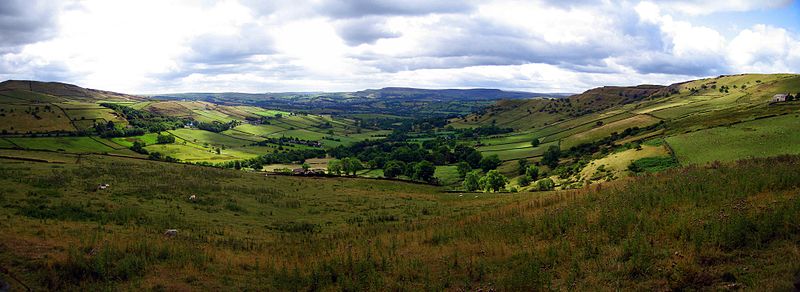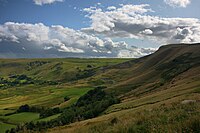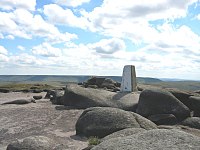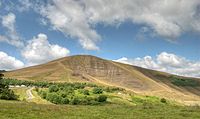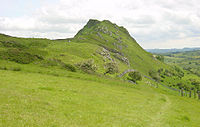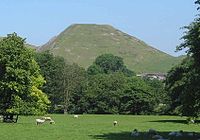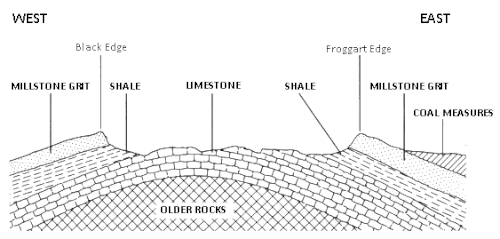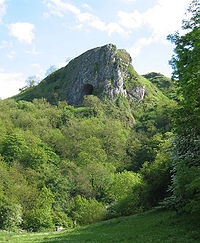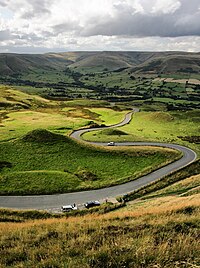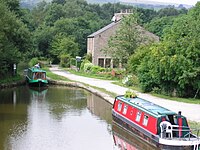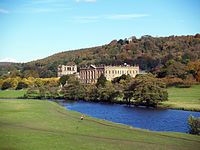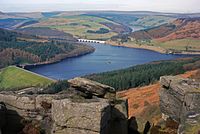Peak District
The Peak District, known as The Peak, is a mountainous area lying mainly in northern Derbyshire, and filling the whole northern part of that shire. It is a section of the Pennines, and unbroken fells reach beyond the Peak to the south-west (the Staffordshire Moorlands and to the north, in the Yorkshire Pennines. The Peak itself trespasses outside it own county into Cheshire and Yorkshire. The highest point of Staffordshire is in the Peak District on the Derbyshire border, though it is conventional to assign all beyond that county border to the Staffordshire Moorlands.
An area of great diversity, it is conventionally split into the northern Dark Peak, where most of the peat moorland is found (hence the name) and whose geology is gritstone, and the southern White Peak, where most of the population lives and where the geology is mainly limestone-based. These parts are different; the southern, rolling Derbyshire Dales are green and richly grazed in the south, the hills beginning at the very edge of the city of Derby, and becoming higher and more forbidding to the north. The High Peak by contrast is uncompromising fell country, high, steep, wind-blasted, unsullied by roads and unpeopled.
Most of the area falls within the Peak District National Park, whose designation in 1951 made it the first national park in the United Kingdom.[1] Proximity to the major cities of Manchester and Sheffield and other industrial centres of Lancashire and Yorkshire, coupled with easy access by road and rail, have contributed to its popularity. The Peak District is sometimes claimed to attract an estimated 22 million visitors a year, making it the most-visited national park in the world after the Mount Fuji National Park in Japan,[2] but the Peak District National Park Authority believe these figures to be incorrect or unsubstantiated, estimating instead that around 10 million people visit each year.[3]
Contents
Name
The name "Peak District" is generally used, though locally it is also "The Peak". William Caden wrote in his Britannia:
The West part beyond Derwent, which throughout riseth high and peaketh up with hils and mountaines, whence in old time it was called in the old English tongue Peac-lond, and is at this daie, haply for that cause, named the Peake (for that word among us signifieth to appeare aloft).
The name is not from "peak" as in "mountain", which is a word brought by the Normans. It predateds their coming by several centuries, in the Peclond of the Anglo-Saxon Chronicle and the Pecsæte of the Mercian Tribal Hidage. The origin of their name is unknown.
Geography
The Peak District forms the southern end of the Pennines and much of the area is uplands above 1,000 feet, with its high point on Kinder Scout at 2,087 feet; Derbyshire's county top. Despite its name, the landscape generally lacks sharp summits, being characterised by rounded hills and gritstone escarpments (the "edges"). The area is surrounded by major conurbations, including Huddersfield, Manchester, Sheffield, Derby and Stoke-on-Trent.
Some 12% of the Peak District National Park is owned by the National Trust. The three Trust estates (High Peak, South Peak and Longshaw) include the ecologically or geologically significant areas of Bleaklow, Derwent Edge, Hope Woodlands, Kinder Scout, Leek and Manifold, Mam Tor, Dovedale, Milldale and Winnats Pass.[4][5][6] The Peak District National Park Authority directly owns around 5%, and other major landowners include several water companies.
National Park
The National Park covers 555 square miles, including the majority of the Peak. Its northern limits lie along the A62 road between Marsden and Meltham, north-east of Oldham, while its southernmost point is on the A52 road on the outskirts of Ashbourne in Derbyshire. The Park boundaries were drawn to exclude large built-up areas and industrial sites from the park; in particular, the town of Buxton and the adjacent quarries are located at the end of the Peak Dale corridor, surrounded on three sides by the Park. The town of Bakewell and numerous villages are, however, included within the boundaries, as is much of the (non-industrial) west of Sheffield. As of 2010, it is the fifth largest National Park in England and Wales.
Hills of the Peak
Marilyns are marked in boldface. The top three are considered mountains as they are above 2,000 feet high.
| Peak | Absolute height (ft) |
Grid reference |
|---|---|---|
| Kinder Scout | 2,087 | SK085875 |
| Bleaklow | 2,077 | SK092959 |
| Higher Shelf Stones | 2,037 | SK089947 |
| Grindslow Knoll | 1,972 | SK110868 |
| Black Hill | 1,909 | SE078046 |
| Brown Knoll | 1,867 | SK083851 |
| Shining Tor | 1,834 | SJ994737 |
| Axe Edge Moor | 1,808 | SK035706 |
| Lord's Seat | 1,791 | SK113835 |
| Margery Hill | 1,791 | SK189956 |
| Featherbed Moss | 1,788 | SK190938 |
| Featherbed Top | 1,785 | SK090921 |
| Mill Hill | 1,785 | SK064901 |
| Black Chew Head | 1,778 | SE056019 |
| Back Tor | 1,765 | SK197909 |
| Britland Edge Hill | 1,719 | SE106027 |
| Lost Lad | 1,699 | SK193912 |
| Mam Tor | 1,696 | SK127836 |
| Oliver Hill | 1,683 | SK027675 |
| Black Edge | 1,663 | SK062770 |
| Shutlingsloe | 1,660 | SJ976695 |
| The Roaches | 1,656 | SK001638 |
| Burbage Edge | 1,640 | SK029732 |
| West Nab | 1,640 | SK266940 |
Geology
The Peak District is formed almost exclusively from sedimentary rocks dating from the Carboniferous period. They comprise the Carboniferous Limestone, the overlying Gritstone and finally the Coal Measures, though the latter occur only on the extreme margins of the area. In addition there are infrequent outcrops of igneous rocks including lavas, tuffs and volcanic vent agglomerates.[7]'
The general geological structure of the Peak District is that of a broad dome, whose western margins have been most intensely faulted and folded. Uplift and erosion have effectively sliced the top off the dome to reveal a concentric outcrop pattern with Coal Measures rocks on the eastern and western margins, Carboniferous Limestone at the core and with rocks of Millstone Grit outcropping between these two. The southern edge of the dome is overlain by sandstones of Triassic age though these barely impinge upon the National Park.
The central and southern section of the Peak District, where the Carboniferous Limestone is found at or near the surface, is known as the White Peak in contrast to the Dark Peak, which is characterised by Millstone Grit outcrops and broad swathes of moorland.
Earth movements both during and after the Carboniferous period resulted in the up-doming of the area and, particularly in the west, the folding of the rock strata along north–south axes. The region was raised in a north–south line which resulted in this dome-like shape[8] and the shale and sandstone were worn away until limestone was exposed. At the end of this period, the Earth's crust sank here which led to the area being covered by sea, depositing a variety of new rocks.[9]
Some time after its deposition, mineral veins were formed in the limestone. These veins and rakes have been mined for lead since Roman times.[9]
The Peak District was overrun by ice during at least one of the ice ages of the last two million years (probably the Anglian glaciation of around 450,000 years ago) as evidenced by the patches of glacial till or boulder clay that can be found across the area. It was not, however, covered by ice during the last glacial period, which peaked around 20,000–22,000 years ago. However a mix of Irish Sea and Lake District ice did butt up against its western margins. Glacial meltwaters eroded a complex of sinuous channels along this margin of the Peak District during this period.[10] Glacial meltwaters also contributed to the formation and development of many of the caves in the limestone area.[11] Wild animal herds roamed the area, and their remains have been found in several of the local caves.[9]
The different types of rock that lie beneath the soil strongly influence the landscape; they determine the type of vegetation that will grow, and ultimately the type of animal that will inhabit the area.[12] Limestone has fissures and is soluble in water, therefore rivers have been able to carve deep, narrow valleys. These rivers then often find a route underground, creating cave systems. Millstone Grit on the other hand is insoluble but porous, so it absorbs water which often seeps through the grits, until it meets the less porous shales beneath, creating springs when it reaches the surface again. The shales are friable and easily attacked by frost, so they form areas that are vulnerable to landslides, as on Mam Tor.[8]
Rivers
The high moorland plateau of the Dark Peak and the high ridges of the White Peak are the sources of many rivers. In a report for the Manchester Corporation, the engineer John Frederick Bateman wrote in 1846:
Within ten or twelve miles of Manchester, and six or seven miles from the existing reservoirs at Gorton, there is this tract of mountain land abounding with springs of the purest quality. Its physical and geological features offer such peculiar features for the collection, storage and supply of water for the use of the towns in the plains below that I am surprised that they have been overlooked.—John Frederick Bateman, [13]
He was referring to Longdendale, and the upper valley of the River Etherow. The western side of the Peak District is drained by the rivers Etherow, Goyt, and Tame, which are tributaries of the River Mersey. The north-east is drained by tributaries of the River Don, itself a tributary of the Yorkshire Ouse. Of the tributaries of the River Trent, that drain the south and east, the River Derwent is the most prominent. It rises in the Peak District on Bleaklow just east of Glossop and flows through the Upper Derwent Valley with its three reservoirs, the Howden Reservoir, Derwent Reservoir and Ladybower Reservoir.[14] The River Noe and the River Wye are tributaries.[15] The River Manifold[16] and River Dove,[17] rivers of the south-west whose sources are on Axe Edge Moor, also flow into the Trent, while the River Dane[18] flows into the River Weaver.
Nature
The gritstone and shale of the Dark Peak supports heather moorland and blanket bog environments, with rough sheep pasture and grouse shooting being the main land uses. The limestone plateaux of the White Peak are more intensively farmed, with mainly dairy usage of improved pastures. Some sources also recognise the South West Peak (near Macclesfield) as a third type of area, with intermediate characteristics.[19]
Woodland forms around 8% of the Peak National Park. Natural broad-leaved woodland is found in the steep-sided, narrow dales of the White Peak and the deep cloughs of the Dark Peak, while reservoir margins often have coniferous plantations.
Lead rakes, the spoil heaps of ancient mines, form another distinctive habitat in the White Peak, supporting a range of rare metallophyte plants, including Spring Sandwort (Minuartia verna; also known as leadwort), Alpine Pennycress (Thlaspi caerulescens) and Mountain Pansy (Viola lutea).[20]
Economy
Tourism is the major local employment for Park residents (24%), with manufacturing industries (19%) and quarrying (12%) also being important; only 12% are employed in agriculture. The cement works at Hope is the largest single employer within the Park. Tourism is estimated to provide 500 full-time jobs, 350 part-time jobs and 100 seasonal jobs.[21]
Limestone is the most important mineral quarried, mainly for roads and cement; shale is extracted for cement at Hope, and several gritstone quarries are worked for housing. Lead mining is no longer economic, but fluorite, baryte and calcite are extracted from lead veins, and small-scale Blue John mining occurs at Castleton.
The springs at Buxton and Ashbourne are exploited to produce bottled mineral water, and many of the plantations are managed for timber. Other manufacturing industries of the area are varied; they include David Mellor's cutlery factory in Hathersage, Ferodo brake linings in Chapel-en-le-Frith and electronic equipment in Castleton. There are approximately 2,700 farms in the National Park, most of them under 99 acres in area. 60% of farms are believed to be run on a part-time basis where the farmer has a second job.[21]
History
Early history
The Peak District has been inhabited from the earliest periods of human activity, as is evidenced by occasional finds of Mesolithic flint artefacts and by palaeoenvironmental evidence from caves in Dovedale and elsewhere. There is also evidence of Neolithic activity, including some monumental earthworks or barrows (burial mounds) such as that at Margery Hill. In the Bronze Age the area was well populated and farmed, and evidence of these people survives in henges such as Arbor Low near Youlgreave, or the Nine Ladies Stone Circle at Stanton Moor.[22] In the same period, and on into the Iron Age, a number of significant hillforts such as that at Mam Tor were created. Roman occupation was sparse but the Romans certainly exploited the rich mineral veins of the area, exporting lead from the Buxton area along well-used routes. There were Roman settlements, including one at Buxton which was known to them as "Aquae Arnemetiae" in recognition of its spring,[23] dedicated to the local goddess.
In the Anglo-Saxon period this was the land of Pecsætan a tributary kingdom of the Mercians recorded in the Mercian Tribal Hidage. This tribe may have given the Peak its name.
Mining and quarrying
In mediæval and early modern times the land was mainly agricultural, as it still is today, with sheep farming, rather than arable, the main activity in these upland holdings. However, from the 16th century onwards the mineral and geological wealth of the Peak became increasingly significant. Not only lead, but also coal, fluorite, copper (at Ecton), zinc, iron, manganese and silver have all been mined here.[24] Celia Fiennes, describing her journey through the Peak in 1697, wrote of
... those craggy hills whose bowells are full of mines of all kinds off black and white and veined marbles, and some have mines of copper, others tinn and leaden mines, in w[hi]ch is a great deale of silver.—Celia Fiennes[25]
Coal measures occur on the western and the eastern fringes of the Peak District, and evidence of past workings can be found from Glossop down to The Roaches, and from Stocksbridge to Baslow. Mining started in mediæval times and was at its most productive in the 18th and early 19th centuries, in some cases continuing into the early 20th century. The earliest mining took place at and close to outcrops and miners eventually followed the seams deeper underground as the beds dipped beneath hillsides. At Goyt's Moss and Axe Edge, deep seams were worked and steam engines raised the coal and dewatered the mines.[26] Coal from the eastern mines was used in lead smelting, and coal from the western mines for lime burning.[27]
Lead mining peaked in the 17th and 18th centuries; high concentrations of lead have been found in the area dating back from this period, as well as discovering peat on Kinder Scout suggesting that lead smelting occurred.[28] Lead mining began to decline from the mid-19th century, with the last major mine closing in 1939, though lead remains a by-product of fluorite, baryte and calcite mining.[20] Not all mines were deep underground; Bell pits were a cheap and easy way at getting at an ore that lay close to the surface of flat land. A shaft was sunk into the ore and enlarged at the bottom for extraction. The pit was then enlarged further until it became unsafe or worked out, then another pit would be sunk adjacent to the existing one.[28]
Fluorite or fluorspar is called Blue John in the Peak District, the name allegedly coming from the French Bleu et Jaune which describes the colour of the bandings. Blue John is now scarce, and only a few hundred pounds are mined each year for ornamental and lapidary use. The Blue John Cavern in Castleton is a show cave; mining still takes place in the nearby Treak Cliff Cavern.[29]
Industrial limestone quarrying for the manufacture of soda ash started in the Buxton area as early as 1874. In 1926 this operation became part of ICI.[30] Large-scale limestone and gritstone quarry|quarries flourished as lead mining declined, and remain an important if contentious industry in the Peak. Twelve large limestone quarries operate in the Peak; Tunstead near Buxton is one of the largest quarries in Europe.[31] Total limestone output was substantial: at the 1990 peak, 8.5 million tonnes was quarried.
Waterways
The streams of the Peak District have been dammed to provide headwater for numerous water driven mills; weirs have been built across the rivers for the same purpose.
There are no canals within the National Park boundary (though the Standedge Tunnels on the Huddersfield Narrow Canal run underneath the extreme north of the park). Waters from the Dark Peak fed the Ashton Canal, and Huddersfield Narrow Canal, and waters from the White Peak fed the Macclesfield Canal. Outside the National Park, but within the general area, the Peak Forest Canal was built to bring lime from the quarries at Dove Holes for the construction industry. The canal terminated at Bugsworth and the journey was completed using the Peak Forest Tramway. South-east of the National Park, the disused Cromford Canal ran from Cromford to the Erewash Canal and formerly served the lead mines at Wirksworth and cotton mills of Sir Richard Arkwright.
The large reservoirs along the Longdendale valley known as the Longdendale Chain were designed in the 1840s and completed in February 1877. They provided compensation water to ensure a continuous flow along the River Etherow which was essential for local industry, and provided pure water for Manchester.[13] The Upper Derwent Valley reservoirs were built from the mid 20th century onward to supply drinking water to the Midlands and southern Yorkshire.
Development of tourism
The area has been a tourist destination for centuries, with an early tourist description of the area, De Mirabilibus Pecci or The Seven Wonders of the Peak by Thomas Hobbes, being published in 1636.[32] Much scorn was poured on these seven wonders by subsequent visitors, including the journalist Daniel Defoe who described the moors by Chatsworth as "a waste and houling wilderness".
Buxton has a long history as a spa town due to its geothermal spring which rises at a constant temperature of 28 °C. It was initially developed by the Romans around AD 78, when the settlement was known as Aquae Arnemetiae, or "the spa of the goddess of the grove". It is known that Bess of Hardwick and her husband the Earl of Shrewsbury, "took the waters" at Buxton in 1569, and brought Mary, Queen of Scots, there in 1573.[33] The town largely grew in importance in the late 18th century when it was developed by the 5th Duke of Devonshire in style of the spa of Bath. A second resurgence a century later attracted the eminent Victorians such as Dr Erasmus Darwin and Josiah Wedgwood,[34] who were drawn by the reputed healing properties of the waters. The railway reached Buxton in 1863, bringing many more visitors, though long before it had been growing with many notable buildings such as 'The Crescent' (1780–1784), modelled on Bath's Royal Crescent, by John Carr, 'The Devonshire' (1780–1789), 'The Natural Baths', and 'The Pump Room' by Henry Currey. The Pavilion Gardens were opened in 1871.[33] Buxton Opera House was designed by Frank Matcham in 1903 and is the highest opera house in the country. Matcham was the theatrical architect who designed the London Palladium, the London Coliseum, and the Hackney Empire.
There is a great tradition of public access and outdoor recreation in the area. The Peak District formed a natural hinterland and rural escape for the populations of industrial Manchester and Sheffield, and remains a valuable leisure resource in a largely post-industrial economy.
Modern history
The Kinder Trespass in 1932 was a landmark in the campaign for national parks and open access to moorland in Britain. At the time, such open moors were closed to all; they were strongly identified with the game-keeping interests of landed gentry who used them only 12 days a year. The Peak District National Park became the United Kingdom's first national park on 17 April 1951. The first long-distance footpath in the United Kingdom was the Pennine Way, which opened in 1965 and starts at the Nags Head Inn, in Grindsbook Booth, part of Edale village.
The northern moors of Saddleworth and Wessenden, above Meltham, gained notoriety in the 1960s as the burial site of several children murdered by Ian Brady and Myra Hindley.
Visitor attractions
The spa town of Buxton was developed by the Dukes of Devonshire as a genteel health resort in the 18th century; now the largest town in the Peak District, it has an opera house with a theatre, museum and art gallery.[35] Another spa town is Matlock Bath, popularised in the Victorian era. Bakewell is the largest settlement within the National Park; its five-arched bridge over the River Wye dates from the 13th century.[36] Buxton, Matlock and Matlock Bath, Bakewell, Leek and the small towns of Ashbourne and Wirksworth, on the fringes of the Park, all offer a range of tourist amenities. To the north the village of Hayfield sits at the foot of Kinder Scout, the highest summit in the area.
Historic buildings include Chatsworth House, seat of the Dukes of Devonshire and among Britain's finest stately homes; the mediæval Haddon Hall, seat of the Dukes of Rutland; Hardwick Hall, built by powerful Elizabethan Bess of Hardwick; and Lyme Park, an Elizabethan manor house transformed by an Italianate front. Many of the Peak's villages and towns have fine parish churches, with a particularly magnificent example being the 14th century Church of St John the Baptist at Tideswell, sometimes dubbed the 'Cathedral of the Peak'. 'Little John's Grave' can be seen in the Hathersage churchyard.
The picturesque village of Castleton, overshadowed by the Norman Peveril Castle, has four show caves, the Peak, Blue John, Treak Cliff, and Speedwell, and is the centre of production of the unique semi-precious mineral, Blue John.[37] Other show caves and mines include the Heights of Abraham, reached by cable car, at Matlock Bath, and Poole's Cavern in Buxton. The small village of Eyam is known for its self-imposed quarantine during the Black Death of 1665.[38]
The Peak District Mining Museum at Matlock Bath includes tours of the Temple Lead Mine, and the Derwent Valley Mills World Heritage Site and Brindley Water Mill at Leek, and gives insight into the Peak's industrial heritage. The preserved steam railway between Matlock and Rowsley, the National Tramway Museum at Crich and the Cromford Canal chart the area's transport history. The Life in a Lens Museum of Photography & Old Times in Matlock Bath presents the history of photography from 1839.
Well dressing ceremonies are held in most of the villages during the spring and summer months, in a tradition dating from ancient times unknown. Other local customs include Castleton's annual Garland Festival and Ashbourne's Royal Shrovetide Football, played annually since the 12th century. Buxton hosts two opera festivals, the Buxton Festival and the International Gilbert and Sullivan Festival, as well as the Buxton Festival Fringe, and the Peak Literary Festival is held at various locations twice a year.
Peak District food specialities include the dessert Bakewell pudding, very different from the nationally available Bakewell tart, and until 2009 the famous cheese Stilton and other local cheeses were produced in the village of Hartington.
The Peak District in literature and arts
The landscapes of the Peak have formed an inspiration to writers for centuries. Various places in the Peak District have been identified by Ralph Elliott and others as locations in the 14th-century poem Sir Gawain and the Green Knight; Lud's Church for example, is thought to be the Green Chapel.[39]
Key scenes in Jane Austen's 1813 novel Pride and Prejudice are set in the Derbyshire Peak District.[40] Peveril of the Peak (1823) by Sir Walter Scott is a historical novel set at Peveril Castle, Castleton during the reign of Charles II.[41][42] William Wordsworth was a frequent visitor to Matlock; the Peak inspired several of his poems, including an 1830 sonnet to Chatsworth House.[43]
The village of Morton in Charlotte Brontë's 1847 novel Jane Eyre is based on Hathersage, where Brontë stayed in 1845, and Thornfield Hall might have been inspired by nearby North Lees Hall.[44][45] Snowfield in George Eliot's first novel Adam Bede (1859) is believed to be based on Wirksworth, where her uncle managed a mill; Ellastone (as Hayslope) and Ashbourne (as Oakbourne) are also featured.[43]
Beatrix Potter, the author of Peter Rabbit, used to visit her uncle Edmund Potter at his printworks in Dinting Vale. She used cloth patterns from his Pattern Sample book to dress her characters. Mrs Tiggywinkle's shawl, in The Tale of Mrs. Tiggy-Winkle, is based on pattern number 222714.[46]
Children's author Alison Uttley (1884–1976) was born at Cromford; her well-known novel A Traveller in Time, set in Dethick, recounts the Babington Plot to free Mary, Queen of Scots, from imprisonment.[47] Crichton Porteous (1901–91) set several books in specific locations in the Peak; Toad Hole, Lucky Columbell and Broken River, for example, are set in the Derwent Valley.[48]
More recently, Geraldine Brooks's first novel, Year of Wonders (2001), blends fact and fiction to tell the story of the plague village of Eyam,[49] which also inspired Children of Winter by children's novelist Berlie Doherty (b. 1943). Doherty has set several other works in the Peak, including Deep Secret, based on the drowning of the villages of Derwent and Ashopton by the Ladybower Reservoir, and Blue John, inspired by the Blue John Cavern at Castleton.[50]
Many works of crime and horror have been set in the Peak. The Terror of Blue John Gap by Sir Arthur Conan Doyle (1859–1930) recounts terrible events at the Blue John mines,[51] and Sherlock Holmes investigates the kidnapping of a child in the region in The Adventure of the Priory School.[52] Many of the horror stories of local author Robert Murray Gilchrist (1878–1916) feature Peak settings.[43] More recently, Stephen Booth has written a series of crime novels set in various real and imagined Peak locations,[53] while In Pursuit of the Proper Sinner, an Inspector Lynley mystery by Elizabeth George, is set on the fictional Calder Moor.[54]
Other writers and poets who lived in or visited the Peak include Samuel Johnson, William Congreve, Anna Seward, Jean-Jacques Rousseau, Lord Byron, Thomas Moore, Richard Furness, D. H. Lawrence, Vera Brittain, Richmal Crompton and Nat Gould.[43][47]
The landscapes and historic houses of the Peak are also popular settings for film and television. The classic 1955 film The Dam Busters was filmed at the Upper Derwent Valley reservoirs, where practice flights for the bombing raids on the Ruhr dams had been made during the Second World War.[55] In recent adaptations of Pride and Prejudice, Longnor has featured as Lambton, while Lyme Park and Chatsworth House have stood in for Pemberley.[56][57] Haddon Hall not only doubled as Thornfield Hall in two different adaptations of Jane Eyre, but has also appeared in several other films including Elizabeth, The Princess Bride and The Other Boleyn Girl.[58] The long-running television medical drama Peak Practice is set in the fictional village of Cardale in the Derbyshire Peak District; it was filmed in Crich, Matlock and other Peak locations.[59]
Outside links
| ("Wikimedia Commons" has material about Peak District) |
- Peak District National Park Authority
- The National Trust: Peak District
- British Geological Survey: Foundations of the Peak – geological information
References
- ↑ "Quarrying and mineral extraction in the Peak District National Park". Peak District National Park Authority. 2011. http://www.peakdistrict.gov.uk/__data/assets/pdf_file/0009/79227/factsheet4-quarrying.pdf. Retrieved 17 April 2012.
- ↑ Wheeler, T. (2003). Else, D. ed. Britain (5th ed.). Lonely Planet. p. 42. ISBN 1-74059-338-3. "The Peak District alone gets 20 million, making it Britain's most-visited park, and the second-busiest in the world."
- ↑ "Media Centre Facts and Figures". Peak District National Park Authority. http://www.peakdistrict.gov.uk/news/mediacentrefacts. Retrieved 6 October 2011.
- ↑ "High Peak Estate". The National Trust. 2009. Archived from the original on 26 April 2009. http://web.archive.org/web/20090426230500/http://nationaltrust.org.uk/main/w-vh/w-visits/w-findaplace/w-highpeakestate.htm. Retrieved 22 May 2009.
- ↑ "Ilam Park and South Peak Estate". The National Trust. 2010. Archived from the original on 15 July 2010. http://web.archive.org/web/20100715195938/http://www.nationaltrust.org.uk/main/w-ilampark. Retrieved 26 September 2010.
- ↑ "Longshaw Estate". The National Trust. 2009. http://www.nationaltrust.org.uk/main/w-vh/w-visits/w-findaplace/w-longshawestate.htm. Retrieved 22 May 2009.
- ↑ Gannon, Paul, Rock Trails Peak District:A Hillwalker's Guide to the Geology and Scenery, Pesda Press, 2011, ISBN 978-1-906095-24-6
- ↑ 8.0 8.1 Cope, F. W. (1976). Geology Explained in the Peak District. David & Charles. ISBN 0-7153-6945-8.
- ↑ 9.0 9.1 9.2 "The Peak District is a very interesting area geologically". Peak District Information. Cressbrook Multimedia. 2008. http://www.cressbrook.co.uk/features/geology.php. Retrieved 24 May 2009.
- ↑ Aitkenhead, N. et al. 2002 British Regional Geology: the Pennines and adjacent areas (4th Edn) (BGS, Nottingham)
- ↑ Macdougall, D. (2006). The Geology of Britain. University of California Press. ISBN 0-520-24824-4.
- ↑ Toghill, P. (2002). The Geology of Britain. Crowood Press. ISBN 1-84037-404-7.
- ↑ 13.0 13.1 Quayle, Tom (2006). Manchester's Water: The Reservoirs in the Hills. Stroud: Tempus Publishing. p. 15. ISBN 0-7524-3198-6.
- ↑ Bevan, Bill (2004). The Upper Derwent: 10,000 Years in a Peak District Valley. Stroud: Tempus Publishing. pp. 141–159. ISBN 0-7524-2903-5.
- ↑ "River Derwent". Peak District Online. 2009. http://www.peakdistrictonline.co.uk/content.php?categoryId=1593. Retrieved 1 July 2009.
- ↑ "The Manifold is a sister river to the Dove". Peak District Information. Cressbrook Multimedia. 2008. http://www.cressbrook.co.uk/features/manifold.php. Retrieved 1 July 2009.
- ↑ "The Dove is the major river of the South Peak". Peak District Information. Cressbrook Multimedia. 2008. http://www.cressbrook.co.uk/features/dove.php. Retrieved 1 July 2009.
- ↑ "The Dane flows west into Cheshire". Peak District Information. Cressbrook Multimedia. 2008. http://www.cressbrook.co.uk/features/dane.php. Retrieved 1 July 2009.
- ↑ "Peak District National park: Place". Peak District National Park. 2003. http://www.peakdistrict-nationalpark.info/place/characterAreas.html. Retrieved 22 May 2009.
- ↑ 20.0 20.1 "Biodiversity Action Plan – The Lead Legacy". Peak District. 2004. Archived from the original on 20 July 2011. https://web.archive.org/web/20110720112405/http://www.peakdistrict.gov.uk/lead. Retrieved 13 November 2013.
- ↑ 21.0 21.1 Waugh, D. (2000). Geography An Integrated Approach (3rd ed.). Nelson Thornes. ISBN 0-17-444706-X.
- ↑ Bevan, Bill (2007). Ancient Peakland. Wellington: Halsgrove. ISBN 1-84114-593-9.
- ↑ "Aquae Arnemetiae". RomanBritain.org. 2005. http://www.roman-britain.org/places/aquae_arnemetiae.htm. Retrieved 22 May 2009.
- ↑ Ford, T. D. (2002). Rocks and Scenery of the Peak District. Landmark Publishing. ISBN 1-84306-026-4.
- ↑ Fiennes, C. (1888). Through England on a Side Saddle in the Time of William and Mary. London: Field and Tuer, The Leadenhall Press. http://www.visionofbritain.org.uk/text/chap_page.jsp?t_id=Fiennes&c_id=15. Retrieved 22 May 2009.
- ↑ "Goyt's Moss and Axe Edge Moor Update". Environment News 12. Archived from the original on 26 July 2004. https://web.archive.org/web/20040726124922/http://www.coal.gov.uk/media/EB466/Enviro%2012%20P14.pdf. Retrieved 13 November 2013.
- ↑ "Peak District Coal Mining". Peak District National Park. 2003. Archived from the original on 9 August 2010. https://web.archive.org/web/20100809072725/http://www.peakdistrict-nationalpark.info/time/industry/coalmining.html. Retrieved 13 November 2013.
- ↑ 28.0 28.1 "Mining in the Peak District of Derbyshire Lead and Copper Minerals". A Taste of the Peak District. http://www.thepeakdistrict.info/peak-district-mining.php. Retrieved 24 June 2009.
- ↑ "Blue John Stone". BlueJohnStone.co.uk. 2007. http://www.bluejohnstone.co.uk/. Retrieved 30 June 2009.
- ↑ "The Buxton Story". Tarmac. 2006. http://www.tarmac.co.uk/buxtoncement/companyhistory.aspx. Retrieved 1 July 2009.
- ↑ "Peak District industry". British Geological Survey. http://www.bgs.ac.uk/foundation-web/GenericInd.html. Retrieved 22 May 2009.
- ↑ "1678 – De Mirabilibus Pecci – Being the Wonders of the Peak in Darby-shire". British Library. http://www.bl.uk/learning/langlit/texts/tourists/de/darbyshire.html. Retrieved 22 May 2009.
- ↑ 33.0 33.1 "Things to do in Buxton". Quantifying and Understanding the Earth System. http://quest.bris.ac.uk/workshops/annual06/Buxton.pdf. Retrieved 28 June 2009.
- ↑ Darwin, C. (1985). The correspondence of Charles Darwin. Cambridge: Cambridge University Press. http://books.google.com/books?id=ao2I3-8PXBgC&pg=PA265&lpg=PA265&dq=levett+darwin&ct=result. Retrieved 28 June 2009.
- ↑ "Visit Buxton". VisitBuxton.co.uk. 2007. http://www.visitbuxton.co.uk/. Retrieved 18 June 2009.
- ↑ "Bakewell". Places-to-go.org.uk. 2003. http://www.places-to-go.org.uk/Bakewell.htm. Retrieved 18 June 2009.
- ↑ "The World Famous Blue John Cavern And Original Blue John Craft Shop". The Blue John Cavern. http://www.bluejohn-cavern.co.uk/. Retrieved 18 June 2009.
- ↑ "Mystery of the Black Death". Secrets of the Dead. http://www.pbs.org/wnet/secrets/case_plague/index.html. Retrieved 18 June 2009.
- ↑ Elliott, R. W. V.; Brewer D S & Gibson J. (1999). "Landscape and Geography". A Companion to the Gawain-Poet. Brewer D S. pp. 105–117. ISBN 0-85991-529-8.
- ↑ "Pride and Prejudice by Jane Austen". Project Gutenberg. 2003. http://www.gutenberg.org/etext/1342. Retrieved 13 September 2007.
- ↑ "Peveril Castle". English Heritage Archive. 2007. http://pastscape.english-heritage.org.uk/hob.aspx?hob_id=309632. Retrieved 12 September 2007.
- ↑ Ousby, I. (1993). Ousby I. ed. The Cambridge Guide to Literature in English (2nd ed.). Cambridge University Press. p. 734. ISBN 0-521-44086-6.
- ↑ 43.0 43.1 43.2 43.3 "Peak Film & Literature". Peak Experience. http://www.peak-experience.org.uk/tourism/explore-the-guides/peak-experience-guides/peak-film-literature/. Retrieved 12 September 2007.
- ↑ Brontë, C. (1996). Jane Eyre. Penguin Books. p. 526. ISBN 0-14-043400-3.
- ↑ Barker, J. (1995). The Brontës. Weidenfeld & Nicolson. pp. 451–453. ISBN 1-85799-069-2.
- ↑ Potter, E. (1892). "Dinting Vale Printworks cotton sample pattern book". Spinning the Web. Manchester City Council. http://www.spinningtheweb.org.uk/sea_cat_display.php?irn=3004030&sub=&theme=overview&crumb=. Retrieved 28 June 2009.
- ↑ 47.0 47.1 "Peakland Writers". Peakland Heritage. 2008. http://www.peaklandheritage.org.uk/index.asp?peakkey=40600721. Retrieved 12 September 2007.
- ↑ "Crichton Porteous – Derbyshire Writer". About Derbyshire. 3 June 2007. http://www.aboutderbyshire.co.uk/cms/people/crichton-porteous-derbysh.shtml. Retrieved 12 September 2007.
- ↑ "Year of Wonders". GeraldineBrooks.com. 2007. http://geraldinebrooks.com/the-books/year-of-wonders/. Retrieved 13 November 2013.
- ↑ "Berlie Doherty: novels". BerlieDoherty.com. 2003. Archived from the original on 2 August 2007. http://web.archive.org/web/20070802221528/http://www.berliedoherty.com/novelsf.html. Retrieved 12 September 2007.
- ↑ "Tales of Terror and Mystery by Sir Arthur Conan Doyle". Gutenberg. 2008. http://www.gutenberg.org/etext/537. Retrieved 13 September 2007.
- ↑ "The Adventure of the Priory School". Camden House – The Complete Sherlock Holmes. 1998. http://www.ignisart.com/camdenhouse/canon/prio.htm. Retrieved 13 September 2007.
- ↑ "Stephen Booth – New Books". StephenBooth.com. http://www.stephen-booth.com/New%20books.htm. Retrieved 12 September 2007.
- ↑ "Novel – In Pursuit of the Proper Sinner". Elizabeth George Online. http://www.elizabethgeorgeonline.com/books/in_pursuit_of_sinner.htm. Retrieved 12 September 2007.
- ↑ "Filming locations for The Dam Busters". Internet Movie Database. 1990. http://www.imdb.com/title/tt0046889/locations. Retrieved 13 September 2007.
- ↑ "Filming locations for Pride and Prejudice (1995)". Internet Movie Database. 1995. http://www.imdb.com/title/tt0112130/locations. Retrieved 12 September 2007.
- ↑ "Filming locations for Pride and Prejudice (2005)". Internet Movie Database. 2005. http://www.imdb.com/title/tt0414387/locations. Retrieved 12 September 2007.
- ↑ "Film & Photoshoots". Haddon Hall. http://www.haddonhall.co.uk/film.htm. Retrieved 22 June 2009.
- ↑ "Filming locations for Peak Practice". Internet Movie Database. 1993. http://www.imdb.com/title/tt0106097/locations. Retrieved 12 September 2007.

